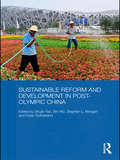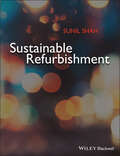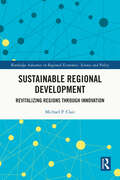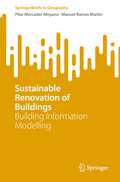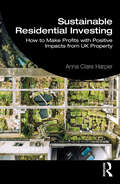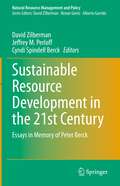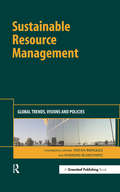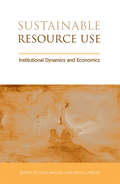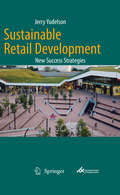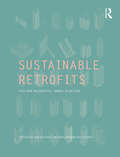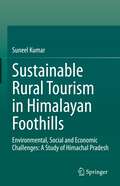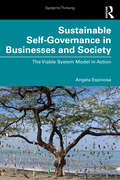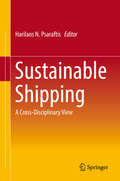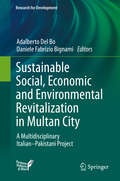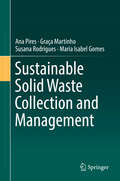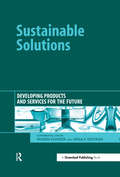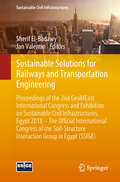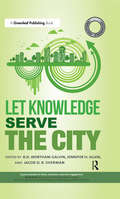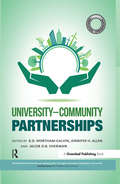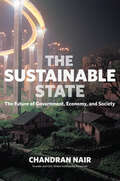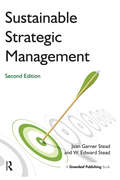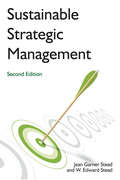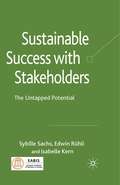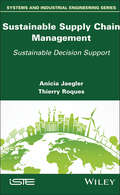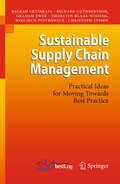- Table View
- List View
Sustainable Reform and Development in Post-Olympic China (Routledge Studies on the Chinese Economy)
by Bin Wu Stephen L. Morgan Dylan Sutherland Shujie YaoAfter thirty years of economic reform, China has reached a crossroads in its development process, and faces many challenges in the use of natural resources, the living environment, and the economic, social and political systems. The sustainability of China’s reform and development is even more salient in the face of the global financial crisis and economic recession. Taking the 2008 Olympic Games in Beijing as an iconic turning-point, the book explores key themes such as economic reform and sustainability, innovation and sustainability, globalisation and social development, and analyses the prospects for sustainable reform and development in Post-Olympic China. The book includes topics such as Chinese banking reforms; the issue of regional inequalities; energy and environmental challenges; industry development and corporate social responsibility, and democracy and media bloggers. With analysis written by experts from a wide range of disciplines, the book will appeal to a wide range of readers interested in China’s environment and sustainable development, economic and political reform, and international relations.
Sustainable Refurbishment
by Sunil ShahThis guide to green 'retro-fitting' for corporate real estate, facility managers and occupiers struggling to reduce their building's carbon footprint will help in the planning and management of a sustainable refurbishment programme.Facilities managers have a key role in improving and maintaining a building's sustainability credentials over its whole life - through benchmarking and developing improvement strategies, energy efficiency measures and installation of low carbon technologies, as well as through waste minimisation and appropriate material use.The first part of the book gives the context, providing the structure and linkage between the other chapters, together with an overview on sustainable development and refurbishment projects separately and the value gained from a sustainable refurbishment.Part 2 details the regulatory and financial drivers, together with market pressures, and provides an overview of where this is leading together with the implications for sustainable refurbishment.Part 3 provides technical support on carbon measures, helping to determine the feasibility of good practices as part of the refurbishment. Included is a review of energy efficiency, renewable and low carbon technologies and embodied carbon to enable lifecycle carbon calculations, together with the necessary behavioural change aspects needed to embed the changes. Linkages and benefits between the technologies will be highlighted.Part 4 reviews refurbishment from a wider environmental perspective, understanding the challenges and opportunities that exist for particular developments from a materials, water, biodiversity and transport perspective.Throughout the book, checklists are provided on typical activities and good practice that should be performed. These are expanded through relevant case studies and examples to show-case previous good practices and lessons learnt.The book is structured to allow a matrix approach, with Parts 3 and 4 providing the technical information necessary to deliver a sustainable refurbishment; with sector relevance and best practice with case studies throughout the book.
Sustainable Regional Development: Revitalizing Regions through Innovation (Routledge Advances in Regional Economics, Science and Policy)
by Michael P. ClairMany communities and regions are being left behind in the new economic order. The book starts with the premise that, in today’s knowledge-based economy, innovation is key, but that only seems to happen in larger urban centres. It seems that smaller centres and peripheral regions can only look forward to decline and eventual irrelevance, but this need not be the case. Wherever there are people, there is the potential to innovate. This book demonstrates that innovators are not limited to inventors and entrepreneurs. Each innovation starts with an idea that is nurtured by its creator and incubated by the larger community. The book identifies different categories of creators such that many readers will recognize themselves as being, in fact, creators. And it identifies different ways of coming up with ideas, which may validate how creators spend their time. It identifies ways to judge whether ideas should be pursued or not and looks at the steps required to turn an idea into an innovation. Many declining communities and regions around the world have resuscitated themselves by being creative and innovative — sometimes in startling ways. This book will provide some ideas to help any region reinvent itself. But having a few individuals with good ideas is not sufficient to revive a region. This book also shows how effective leaders are needed to help stimulate more creative activity and, just as importantly, to coordinate the necessary resources to turn creative ideas into innovations. The book will appeal to students, scholars and researchers of economic, regional, social and sustainable development, innovation, public policy and economic geography, as well as practitioners and policymakers concerned with regional development and regional innovation policies.
Sustainable Renovation of Buildings: Building Information Modelling (SpringerBriefs in Geography)
by Pilar Mercader-Moyano Manuel Ramos MartínThe book provides a complete vision about Spanish sustainable renovation of buildings situation at this moment, analysing legal and technological context and opportunities that economic stimulus —by means of direct aids— and the use of BIM methodologies offers a standardization of high scale interventions.Nowadays, BIM models let us integrate multiple quantitative parameters that can agile the information to interchange between stakeholders. Using this potential to standardize protocols of interventions and share knowledge is necessary to face a high scale intervention that our cities need.Climatic Emergency and socioeconomic crisis caused by recent events —COVID-19 and hydrocarbons crisis— are the two principal struggles we face as society. European Politics, embodied by National Energy and Climate Plans (NECPs) developed by each region give the way to the green transition of different productive sectors.Our building stock is responsible for approximately 36% of the CO2 emissions in the European Union. For this reason, these policies focus a large part of their efforts on economically incentivizing a new development model for the building sector that is committed to the large-scale renovation of the existing real estate stock and that, through the reduction of energy demand and of emissions, manage to reduce the environmental impact of these. Next Generation EU is the new recovery instrument that aims to mobilize investments towards strategic sectors for the reorientation of the production model that, among other measures, contributes to decarbonization through the promotion of energy efficiency and the deployment of renewable energies.
Sustainable Residential Investing: How to Make Profits with Positive Impacts from UK Property
by Anna Clare HarperFor investors from across the world, UK residential property is seen as one of the best investments available. This is for good reason. It has a track record of delivering strong, stable returns in a way that is relatively easy to understand and implement. The trouble is, the market has changed. The investors of the future value sustainability more than ever before. There is unprecedented and growing demand for Environmental Social and Governance (ESG) investing, now worth $30 trillion in Assets Under Management each year, around a quarter of all professionally managed assets. The traditional goal of profit maximisation is being replaced. Investments must increasingly be profitable as well as sustainable: economically resilient with positive ESG metrics. Yet the UK residential property market – worth over £7.5 trillion – is lagging behind. There is very little clear, easily usable guidance for those responsible for a huge proportion of the market: private investors. The positive impacts of sustainable property investing – for profit-motivated investors, people and the planet – could be huge. The financial, environmental and social costs of getting it wrong could be catastrophic. To get this right and to avoid the risks of getting it wrong, it is vital to understand: • What sustainable residential property investing is • What needs to change and • How, on a practical level, you can invest in a way that is both profitable and sustainable. This book draws on expertise from within and beyond real estate, provides a simple framework for updating your approach. It highlights common mistakes and shares advice so that you can avoid them. Ultimately, it’s about answering the question of the decade: ‘How can I invest profitably with positive impacts?’
Sustainable Resource Development in the 21st Century: Essays in Memory of Peter Berck (Natural Resource Management and Policy #57)
by David Zilberman Jeffrey M. Perloff Cyndi Spindell BerckThis is an open access book.This edited volume discusses topics in environmental economics with a focus on sustainability, conservation, and responsible resource management. Written in memory of Peter Berck, Professor of Agricultural and Resource Economics at the University of California, Berkeley, the chapters expand upon his insights about the connections between human activities and the natural world. The volume includes a selection of research on agriculture, energy, forestry, fisheries, land use, recycling, and conservation – all parts of the broad question of how natural resources can meet human needs while avoiding environmental degradation. Written from a 21st century perspective, with concerns about climate, renewable energy, biodiversity, and sustainable development, this volume will be of interest to researchers and students of agricultural and resource economics.
Sustainable Resource Management: Global Trends, Visions and Policies
by Raimund Bleischwitz Stefan BringezuSustainable Resource Management is the result of years of exhaustive research by Germany's Wuppertal Institute. Looking at material flows, industrial and societal metabolism and their implications for the economy, this important new book provides radical perspectives on how the global economy should use natural resources in intelligent ways that maximise well-being without destroying life-supporting ecosystems. It presents a vision of the future and the fundamental elements necessary for the sustainable management of the Earth's resources. It argues that the need to manage the use of our natural resources at a sustainable level can be shaped into a great opportunity for innovation and for new institutions to govern change.Sustainable Resource Management first provides an overview of the methods it has used to analyse the physical basis of our economies, from the product and firm level through to sectors and whole countries, considering material flows and life-cycle-wide impacts on the environment. Indicators are described that reflect the volume, structure and physical growth of the socio-industrial metabolism, resource productivity and the share of domestic and foreign resource use. By accounting for the global land use of different countries and regions, the book aims to better assess the global implications of domestic activities. For example, linkages are made between the consumption of food and non-food to land use change, such as the expansion of cropland at the expense of natural ecosystems.Sustainable Resource Management presents a number of key findings. Comparing the resource use of the EU with the USA, Japan and China, it determines why there is a difference. It provides evidence about the decoupling of resource use from economic growth, at the expense of an increased reliance on foreign supply. There are two closely analysed case studies, on platinum group metals (PGM) and biofuels, which provide insights into the key drivers of resource use and related problem shifting. Another key finding is that only a limited number of sectors, both on the production and consumption side, are actually associated with major resource requirements and atmospheric emissions – so synergies between resource conservation and climate protection can be found. Evidence is also given of a possible link between a low level of resource productivity and a high risk of unemployment.Sustainable Resource Management also looks into the future and provides visions of sustainable resource use, including the necessary conditions for a sustainable metabolism in the EU. Four example-rich visions are laid out approaching the future from different angles: the resource-efficient and recycling-based industry, the steady-stocks society, the solarised technosphere, and the balanced bio-economy. Each examines key conditions for a low-risk and high-opportunity future, while accounting for likely trade-offs between dematerialisation and rematerialisation, between renewable energy sources and non-renewable materials, between construction and deconstruction of buildings and infrastructures, and between domestic production and the import of biomass products.Finally, Sustainable Resource Management provides a blueprint for how a more sustainable future may be achieved. It analyses the legitimacy of public policies for sustainable resource management, looks at market deficits and barriers, and considers the global nature of the challenge. Crucially, it lays down the key elements of a strategy roadmap: First, better information, dissemination and knowledge generation. Second, innovative market policies to encourage new business models. Third, industry-specific policies – particularly where current resource use patterns are significant and a huge demand for adaptation and system innovation exist, such as in automotive or metal production. Last but not least, an international convention on sustainable resource management is proposed.This significant new book will be essential reading for researchers, EU and national governmental officials; and business and NGOs
Sustainable Resource Use: Institutional Dynamics and Economics (Earthscan Research Editions)
by Alex Smajgl Silva LarsonThe way that humans organize both resource access and resource use is vital to the management of natural resources. Within different contexts, institutional arrangements (such as the rules of common and private property rights) become levers by which human behaviours can be modified and steered towards the goals of sustainable natural resource management. Featuring contributions from leading thinkers in the field, this groundbreaking volume examines institutional dynamics from the perspective of natural resource management. The book is organized into four parts. The first discusses institutional diversity and contextual change. Following this, institutional misfit is analysed with a strong focus on the long-term impacts of colonial structures in the Asia-Pacific region. The book then discusses experiences with institutional dynamics in order to ease the tension of such misfits before examining future research needs. Ultimately, through careful argument and by deploying original research, the authors make the case that institutional arrangements cannot be perceived as a set of parameters that can be optimized and locked in for the most efficient functioning of a system; nor can institutions be evaluated outside the context in which they were developed. This is powerful, thought-provoking and important reading for academics, researchers, policy-makers and professionals in resource, institutional and environmental economics and land use planning and policy across the full range of natural resource sectors from forestry to agriculture. Published with CSIRO. Cover image: Blue Flower of Life (c) Theresa J. Richardson 2006
Sustainable Retail Development: New Success Strategies
by Jerry YudelsonSustainable Retail Development, addresses the emerging issue of green retail buildings and retail development that will grow significantly in importance over the next half-decade, a trend seen throughout the developed world. This volume is a practical and comprehensive guide to greening retail real estate, including green building and marketing strategies, corporate sustainability programs and features a 10-point "action program" for greening any retail real estate portfolio. Sustainable Retail Development, should be essential reading for professionals in design, construction and operations of shopping centers and retail stores. Well illustrated, this volume features over 30 green retail developments from North America, Europe, South America, Asia and Australia, as well as interviews with 25 leading industry experts.
Sustainable Retrofits: Post War Residential Towers in Britain
by Asterios Agkathidis Rosa Urbano GutiérrezPresenting the state-of-the-art in sustainable retrofits in post war residential towers, this book captures and re-informs the current intense refurbishing process that is taking place in Britain, which is part of a global phenomenon happening all over the world, as cities upgrade their building stock in an attempt to comply with governmental emission reduction targets. The authors present inspections of 20 sustainably retrofitted social housing towers, analysing their aesthetic and technical modifications, as well as the shifts occurring in their social structure. The authors use over 200 full colour plans, elevations, photographs, maps and illustrations to beautifully support the statistical and analytical information collected. Finally they include interviews with some of the architects who designed the retrofits, residents and key stakeholders to inform the conclusions.
Sustainable Rural Tourism in Himalayan Foothills: Environmental, Social and Economic Challenges: A Study of Himachal Pradesh
by Suneel KumarThis book discusses the development of the rural tourism industry in the Himalayan region, specifically in the region of Himachal Pradesh (HP), from the perspective of different stakeholders in the tourism industry. It examines the current status and trends of rural tourism in HP, discusses the challenges faced in response to the vulnerability of the Himalayas to global climate change, and evaluates the consequences of rural tourism on the socio-economic structure in HP to sustainably formulate a framework for promoting financial and social inclusion. This framework covers flexible strategies for planning rural tourism development, assesses the role of technology in the tourism industry in achieving the objective of social and financial inclusion, and identifies the factors influencing a tourist’s decision to undertake rural tourism and develop a hierarchical relationship among those factors. The book will be of interest to students and researchers of sustainable rural tourism and tourism economics, as well as stakeholders from various sectors aiming to sustainably improve the ecological and economic fragility of the Himalayas due to climate change.
Sustainable Self-Governance in Businesses and Society: The Viable System Model in Action (Systems Thinking)
by Angela EspinosaSustainable Self-Governance in Businesses and Society offers a sound introduction to Stafford Beer’s Viable System Model (VSM) and clarifies its relevance to support organisational sustainability and self-governance. While the VSM has been known since the early 1980s, it hasn’t been always easy to understand and to apply. It explains the self-transformation methodology to analyse the way organisations manage (or not) their complexity and govern themselves. The work is supported by multiple examples of application in organisations of all scales – from small to multi-national corporations and from organised social networks to communities and national organisations. It clarifies the relevance of Beer’s theory to support systemic learning and change in organisations, and to coach them to self-organise and self-govern. Readers interested in further understanding insights from complex systems and cybernetics theories for designing and transforming organisations will benefit from this book, as it works to offer very detailed insights on how to put the VSM theory into practice. It clarifies how it improves adaptive capabilities, agile and self-regulated structures, more capable of fully implementing corporate sustainability strategies and self-governing themselves. The chapters provide key reading for managers, consultants, practitioners, and post-graduate students working in organisational transformation, governance, and sustainability.
Sustainable Shipping: A Cross-disciplinary View
by Harilaos N. PsaraftisInternational shipping is currently at a crossroads. The decision of the International Maritime Organization (IMO) in April 2018 to adopt an Initial Strategy so as to achieve by 2050 a reduction of at least 50% in maritime greenhouse gas (GHG) emissions vis-à-vis 2008 levels epitomizes the last among a series of recent developments as regards sustainable shipping. It also sets the scene on what may happen in the future. Even though many experts and industry circles believe that the IMO decision is in line with the COP21 climate change agreement in Paris in 2015, others disagree, either on the ground that the target is not ambitious enough, or on the ground that no clear pathway to reach the target is currently visible. This book takes a cross-disciplinary view of the various dimensions of the maritime transportation sustainability problem. “Cross-disciplinary” means that a variety of angles are used to examine the book topics, and these mainly include the technological angle, the economics angle, the logistics angle, and the environmental angle. The book reviews models that can be used to evaluate decisions, policy alternatives and trade-offs. For sustainable shipping, a spectrum of technical, logistics-based and market based measures are being contemplated. All may have important side-effects as regards the economics and logistics of the maritime supply chain, including ports and hinterland connections. The objective to attain an acceptable environmental performance, while at the same time respecting traditional economic performance criteria so that shipping remains viable, is and is likely to be a central goal for both industry and policy-makers in the years ahead. At the same time, policy fragmentation is likely to create distortions of competition and sub-optimal solutions. This book attempts to address these issues and identify better solutions. Sustainable Shipping: A Cross-Disciplinary View includes chapters that cover many relevant topics. These include a general view of maritime transport sustainability, green ship technologies, information and communication technologies (ICTs) for sustainable shipping, green tramp ship routing and scheduling, green liner network design and speed optimization. Market based measures, oil pollution, ship recycling, sulphur emissions, ballast water management, alternative fuels and green ports are also covered. The book concludes by discussing prospects for the future, with a focus on the IMO Initial Strategy
Sustainable Social, Economic and Environmental Revitalization in Multan City
by Adalberto Del Bo Daniele Fabrizio BignamiThis book describes six months of initial intensive activities within a motivating multidisciplinary project to achieve sustainable social, economic, and environmental revitalization in the historic core of Multan City, Pakistan. The project is managed by Fondazione Politecnico di Milano within the framework of the "Pakistan-Italian Debt for Development Swap Agreement" and has five components: a livelihood improvement program, a living conditions improvement program, revitalization of physical assets, establishment of a Pakistan-Italian resource centre in Multan, and an Italian collaboration program for training and capacity building. All aspects are covered in this book, which provides a comprehensive account of progress in this excellent example of cross-cultural cooperation between a Western and an Eastern country in regenerating an historic populated site.
Sustainable Solid Waste Collection and Management
by Maria Isabel Gomes Susana Rodrigues Graça Martinho Ana PiresThis volume focuses on the collection of waste and waste streams as an integral aspect of sustainable waste management. The authors take economic models and behavioral studies into account to go beyond just descriptions of waste collections technologies and collection route design. Models and tools for sustainable waste collection are described in detail, and the authors provide a comprehensive, integrated methodology to design waste collection systems that reduce environmental impacts, are economically viable, and achieve buy-in and participation from target populations. Part I of the book provides fundamentals and context on waste hierarchy, including waste prevention, reduction and reuse, waste collection itself, and steps such as preparation for recycling, recycling, treatment, and landfilling. Background in environmental, social, and economic concerns surrounding waste collection is also provided here. Part II addresses tools for design, operation, and maintenance of waste collection systems. Part III focuses on how the tools presented in Part II can be used to support sustainability assessments and decisions that consider the entire life cycle of waste and the role of waste collection programs in waste prevention, reduction, reuse, recycling, treatment, and disposal. Part IV addresses the challenges of developing sustainable waste management systems and addresses the role of waste collection in sustainable waste management in the future.
Sustainable Solutions: Developing Products and Services for the Future
by Martin Charter Ursula TischnerToughening environmental legislation, national and supra-national environmental product policies and growing customer demands are focusing the attention of companies on the environmental and broader social issues linked to the creation and delivery of their products and services. There is now an urgent need for appropriate management structures, practical tools and increased awareness among all stakeholders in the product development process and throughout the entire product life-cycle. These are huge issues – with major implications for corporate management, design and production strategies. Sustainable Solutions provides state-of-the-art analysis and case studies on why and how cutting-edge companies are developing new products and services to fit "triple-bottom-line" expectations. The book is split into three sections: first, the broad issues of business sustainability are examined with focus on sustainable production and consumption and consideration of North–South issues. Second, the book tackles the major methodologies and approaches toward organising and developing more sustainable products and services. Third, an outstanding collection of global case studies highlights the progress made by a wide range of companies toward dematerialisation, eco-innovation and design for durability. Finally, the book collects together a comprehensive list of web addresses of useful organisations. Practical and comprehensive, Sustainable Solutions will be essential reading for corporate managers, product designers, R&D staff, academics and all individuals interested in a definitive source on how new product and service development can and is contributing toward tacking the challenge of sustainable development.
Sustainable Solutions for Railways and Transportation Engineering: Proceedings of the 2nd GeoMEast International Congress and Exhibition on Sustainable Civil Infrastructures, Egypt 2018 – The Official International Congress of the Soil-Structure Interaction Group in Egypt (SSIGE) (Sustainable Civil Infrastructures)
by Sherif El-Badawy Jan ValentinThis volume brings together scientific experts in different areas that contribute to the railway track and transportation engineering challenges, evaluate the state-of-the-art, identify the shortcomings and opportunities for research and promote the interaction with the industry. In particular, scientific topics that are addressed in this volume include railway ballasted track degradation/settlement problems and stabilization/reinforcement technologies, switches and crossings and related derailments causes, train-induced vibrations and mitigation measures, operations, management and performance of ground transportation, and traffic congestion and safety procedures. The volume is based on the best contributions to the 2nd GeoMEast International Congress and Exhibition on Sustainable Civil Infrastructures, Egypt 2018 – The official international congress of the Soil-Structure Interaction Group in Egypt (SSIGE).
Sustainable Solutions: Let Knowledge Serve the City
by B.D. Wortham-Galvin Jennifer H. Allen Jacob D.B. ShermanPortland, Oregon. Sustainability might not seem glamourous, but Portland is making a name for itself as one of the most sustainable cities in the world. Whether you’ve heard about the farmers’ markets, the cycle-friendly streets or the ongoing efforts to balance livability and equity, Portland is leading the way in urban sustainability: this book helps us understand how it achieves this.A critical component of Portland’s success is collaboration between different communities and institutions; the Sustainable Solutions series examines higher education’s role in these partnerships. In exploring how best to “let knowledge serve the city”, Portland State University translates its founding motto from mere words to applied research and action.This first volume examines different approaches to collaborative work that PSU has taken, both within the university and with community partners: how have barriers been overcome between different areas of study, between academia and the public, and why is bridging these divides so important? It also introduces the themes of the engaged university, social justice, climate change and sustainable economic development, which shape PSU’s work.Let Knowledge Serve the City is ideal for anyone seeking best practice in connecting students and universities with the needs of local communities. From public interest design and student leadership, to food justice and age-friendly development, authors combine academically rigorous theories of sustainability and community-university partnerships with lessons learned on how to realize ideals of sustainable development.
Sustainable Solutions: University–Community Partnerships (Sustainable Solutions Ser. #2)
by B.D. Wortham-Galvin Jennifer H. Allen Jacob D.B. ShermanWhat is the role of the university? Current systems may stress research output, but Wortham-Galvin, Allen, and Sherman seek to re-establish the importance of teaching and service in the work of the 21st-century university. The Sustainable Solutions series shares Portland State University’s experience of community-engaged teaching and research. With a focus on sustainability, we see that such collaboration is vital to making Portland one of the world’s most sustainable cities.Volume 2, University–Community Partnerships, builds on the themes introduced in Volume 1, Let Knowledge Serve the City, to explore how these partnerships play out in practice. Covering 13 projects, which range from supporting local artisans and researching food access, to sharing Indigenous history and decolonizing perceptions of knowledge, readers receive pragmatic advice on working with community organizations. Authors also offer critical reflection on how theories of engagement have structured PSU’s work and how their findings impact our very understanding of partnership.This reader-friendly text provides an ideal introduction to anyone wishing to learn more about models of effective collaboration and how to put these into practice. Explained through the context of specific projects, the book offers both inspiration and practical guidance to anyone — in local government, academia, or the third sector — looking to set up productive community–university partnerships.
The Sustainable State: The Future of Government, Economy, and Society
by Chandran NairThe free-market, limited government development model has been an ecological and social disaster for the developing world. Sustainable and equitable development is only possible with the active involvement of a strong central state that can guide the economy, protect the environment, and prioritize meeting their people's basic needs. In this sure to be controversial book, Chandran Nair shows that the market-dominated model followed by the industrialized west is simply not scalable. The United States alone, with less than five percent of the world's population, consumes nearly a quarter of its resources. If countries in Asia, where 60% of the world's population lives, try to follow the Western lead, the results will be calamitous. .Instead, Nair argues that development must be directed by a state that is willing and able to intervene in the economy . Corporations, which by design demand ever-expanding consumption, need to be directed towards meeting societal needs or otherwise restrained, not unleashed. Development has to be oriented towards the greatest good—clean drinking water for the many has to take precedence over swimming pools for the few. He provides three compelling case studies demonstrating the benefits of such strong state governance and the findings of weak state governance.This will mean rethinking the meaning of concepts like “prosperity,” “freedom,” and “rights,” and whether democracy is always the best way to ensure responsive government—as Nair writes, “A democracy that cannot work to improve the life of its citizens is not better than a non-democracy that can actually improve quality of life.” Many people will find these to be challenging ideas, but what Nair offers is a model suited to the realities of the developing world, not the assumptions of the dominant culture.
Sustainable Strategic Management
by Jean Garner Stead W. Edward Stead“Sustainable strategic management” refers to strategic management policies and processes that seek competitive advantages consistent with a core value of environmental sustainability.This book has been specifically written as a text to augment traditional graduate and undergraduate management courses on strategic management. It fills the need for a strategy text that gives full attention to sustainability and environmental protection. The authors have structured the book to follow the usual order of topics in any standard management text. Sustainable Strategic Management also features an on-going, chapter-by-chapter case study (Eastman Chemical Company) that exemplifies many of the principles of environmentally sound management practices.From creating organizational visions, to formulating goals and strategies, to strategy implementation and evaluation, this book provides readers with new ways of thinking about their organization’s role in the greater society and ecosystem. From the Authors’ Preface:Ours is the first book to integrate sustainability into strategic management. It covers the full gamut of strategic management concepts and processes that would be expected in any quality strategic management book, and it does so in a way that thoroughly weaves sustainability into each and every one of them. Students using this book understand such things as: why reducing materials and energy intensity is an effective functionallevel strategy, why socially differentiated products command premium prices, and why a business ecosystem pursuing a vision of social and ecological responsibility can dominate its market. Further, because the book is relatively short, reasonably priced, and very thorough in its coverage of strategic management concepts and ideas, it can be used either as a stand-alone text for graduate and undergraduate strategic management courses, as a supplement to another book, or as one of a group of short texts.
Sustainable Strategic Management
by Jean Garner Stead W Edward SteadSustainable strategic management (SSM) involves analysing, formulating, and implementing business strategies that are economically competitive, socially responsible, and in balance with the cycles of nature. SSM has emerged from the coevolutionary interactions of business organisations with the society they serve and the planet they call home. SSM strategic portfolios allow organisations to create competitive advantages by serving as agents of social change and ecological protection.This book has been specifically written as a text for traditional graduate and undergraduate strategic management courses, and its short length makes appropriate as a supplementary text in these courses as well. The authors have structured the book to follow the standard strategic management process, and they have included an ongoing descriptive case on Eastman Chemical Company designed to provide an in-depth example of the concepts presented in the chapters.From creating organisational visions and missions, to formulating, implementing, and evaluating goals and strategies, this book provides readers with new ways of thinking about their organisation's strategic role in the greater society and ecosystem now and in the future.
Sustainable Success with Stakeholders
by Sybille Sachs Edwin Ruhli Isabelle KernThis book shows managers how they can identify their stakeholders and cooperate with them in a mutually successful and satisfying way. It includes numerous examples from case studies and international firms, illustrating the stepping stones to a comprehensive stakeholder management.
Sustainable Supply Chain Management: Sustainable Decision Support
by Anicia Jaegler Thierry RoquesSupply chains are now more essential than ever to the functioning of our society; however their environmental and societal impacts are often subject to well-founded criticism. Transforming a supply chain to make it more sustainable and responsible often requires a considerable amount of time and resources. The aim of this book is to present a number of simple best practices that can reduce these negative impacts and make supply chains more virtuous. Sustainable Supply Chain Management is a handbook for supply chain transformation. It explores the different facets of the supply chain, from product design or procurement to logistics operations management and performance. It offers a guide to actions for sustainable supply chain transformation, providing elements of the legal framework for possible actions and tools for measuring the performance that can be achieved.
Sustainable Supply Chain Management
by Thorsten Klaas-Wissing Christoph Tyssen Balkan Cetinkaya Richard Cuthbertson Graham Ewer Wojciech PiotrowiczThis book focuses on the need to develop sustainable supply chains - economically, environmentally and socially. This book is not about a wish list of impractical choices, but the reality of decisions faced by all those involved in supply chain management today. Our definition of sustainable supply chains is not restricted to so-called "green" supply chains, but recognises that in order to be truly sustainable, supply chains must operate within a realistic financial structure, as well as contribute value to our society. Supply chains are not sustainable unless they are realistically funded and valued. Thus, a real definition of sustainable supply chain management must take account of all relevant economic, social and environmental issues. This book contains examples from a wide range of real-life case studies, and synthesizes the learnings from these many different situations to provide the fundamental building blocks at the centre of successful logistics and supply chain management.
